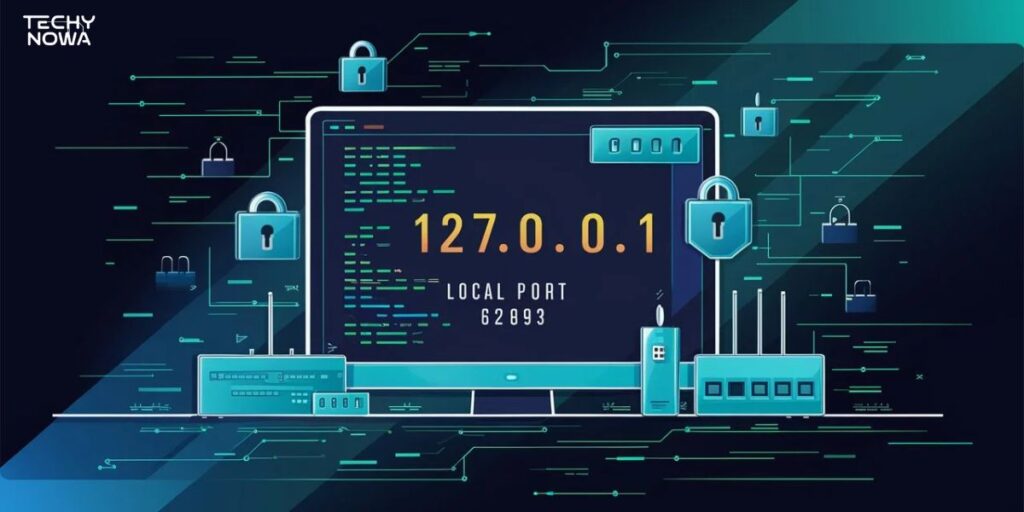127.0.0.1:62893 is a local address and port combination. It is used for testing and development on your own machine. 127.0.0.1 is called the loopback address. Port 62893 is a temporary or dynamic port. This setup helps run and debug local servers. It works without an internet connection. Developers use it for safe and private experiments. This guide explains its meaning and usage in detail.
What Is 127.0.0.1:62893?
It is a combination of an IP address and port number. 127.0.0.1 is the loopback address for your own computer. It is used for local testing and server setup. Port 62893 is a temporary or dynamic port. This port is assigned by the operating system. It changes based on the program or service running. The pair allows programs to communicate internally. It works without sending data over the internet.
127.0.0.1:62893 is important for developers and testers. It helps create and test applications locally. The loopback address ensures privacy and safety. The port number directs traffic to a specific process. This setup avoids interfering with live servers. It is used in web, app, and API testing. Many tools and frameworks rely on it. It makes debugging faster and more secure.
Related guide: MS Word 2007 Tutorial: Learn Basics Fast
Benefits of Using Localhost on Port 62893
- Keep testing safe and private within your own computer.
- Works without needing an internet connection.
- Protects sensitive data from outside access.
- Uses a dedicated port for clear process separation.
- Avoids problems on live production servers.
- Works well with many development tools and languages.
- Makes debugging faster and easier.
- Simulates a real server for better preparation.
Related guide: Best AI Tools For Making Pinterest Graphics In 2025
How to Use 127.0.0.1:62893

To use 127.0.0.1:62893, start by running your local server. Make sure the server listens on port 62893. Open your browser or tool and type 127.0.0.1:62893. This will connect you to the local service. You can test, debug or develop your app here. Close the server when your work is done.
Accessing 127.0.0.1:62893 via a Web Browser
Open your preferred web browser. Type 127.0.0.1:62893 in the address bar. Press Enter to load the page. The browser connects to your local server. You can view and test your application here. Refresh to see updates instantly. Close the tab when finished.
Accessing 127.0.0.1:62893 via Development Tools and Servers
Start your local development server. Ensure it is set to use port 62893. Open your development tool or IDE. Enter 127.0.0.1:62893 in the tool’s browser or preview option. The tool will display your local project. Make changes and see them in real time. Stop the server after testing.
Accessing 127.0.0.1:62893 via Command Line Tools and Scripts
Open your command line or terminal. Type a command like curl 127.0.0.1:62893.
Press Enter to run it. The terminal will show the server response. You can run scripts to test APIs locally. This is fast for debugging and automation. Exit the terminal when done.
Common 127.0.0.1:62893 Errors
One common error is Connection Refused. This happens when the server is not running. Another issue is Address Already in Use. It means another process is using port 62893.
Page Not Found can also appear. This may be due to a wrong path. A Timeout Error happens when the server is too slow. These errors can interrupt local testing.
Restarting the server often fixes connection issues. Changing the port can solve conflicts. Check firewall settings if the port is blocked. Verify the correct URL and path. Make sure the service is running properly. Close unused applications using the same port.
Update your development tools if needed. Quick fixes keep your workflow smooth.
Troubleshooting 127.0.0.1:62893
First, check if your server is running. Make sure it is set to port 62893. Restart the server to refresh the connection. Look for any error messages in the console. Ensure no other program is using the port. Close unused applications that may conflict. Check your firewall settings. Allow access to the local port if blocked.

If you get a connection refused, verify the server status. Change the port if 62893 is already taken. Update your development tools if outdated. Clear your browser cache for web tests. Use netstat or lsof to check port usage. Restart your computer to reset network settings. Test with another tool like curl. Confirm your code or app is running correctly.
Security Considerations for 127.0.0.1:62893
127.0.0.1 is safe because it stays on your computer. But open ports like 62893 can still face risks if apps misuse them. Always use strong firewalls and updated software. I once left a test server running and my antivirus flagged unusual activity. Closing the port quickly kept my system safe.
Real-World Use Cases of 127.0.0.1:62893
This port helps developers test apps locally before going live. It allows secure testing without affecting real servers. I used 127.0.0.1:62893 while building a website to check database connections. The process felt easy and safe. Testing locally saved time and avoided costly hosting mistakes before the final launch.
Best Practices for Using 127.0.0.1:62893
Always start with a secure and updated development setup. Use a firewall to block unnecessary external access. Assign port 62893 only when needed. Close the port after finishing your work. Test your application in small steps. Keep server logs for troubleshooting. Use simple configurations for easy setup. Document your settings for future use.

Avoid running multiple services on the same port. Check port usage before starting your server. Use command line tools to monitor connections. Backup your project regularly. Update your development tools often. Separate test and production environments. Limit access to trusted users only. Review security settings before deployment.
Frequently Asked Questions
What is 127.0.0.1:62893?
It is a localhost address with port 62893 used for local communication on your computer.
Why is port 62893 used?
It is a dynamic port automatically assigned for temporary local connections.
Can I access 127.0.0.1:62893 without the internet?
Yes. Localhost works even without an internet connection.
Why do I get “Connection refused” on 127.0.0.1:62893?
The server may not be running or listening on that port.
How can I check if port 62893 is in use?
Use commands like netstat or lsof to see if a process is using it.
Conclusion
127.0.0.1:62893 is a localhost address with a specific port. It is used for local communication on the same machine. Developers use it for testing and debugging software. It works without an internet connection. This makes it safe and private. It also helps speed up development tasks. Understanding it makes troubleshooting easier.
Using 127.0.0.1:62893 can prevent many network issues. It keeps your testing environment secure. You can run and check applications locally. It avoids exposing services to the public internet. It is useful for both beginners and experts. Simple commands can check or fix errors. Knowing this address improves software work.








